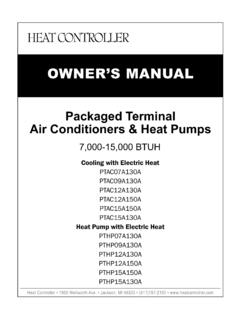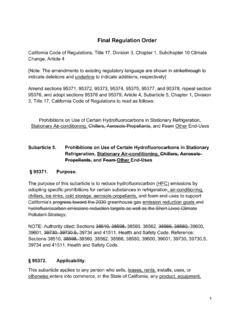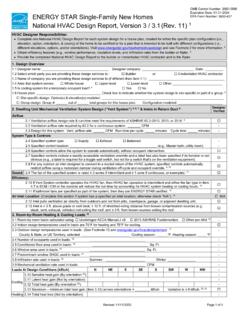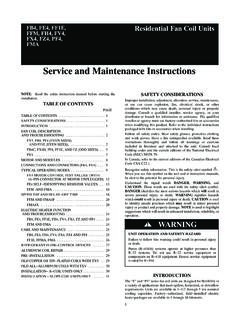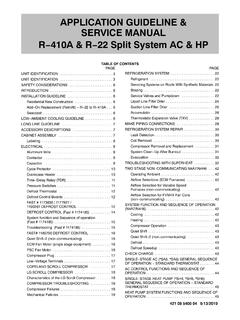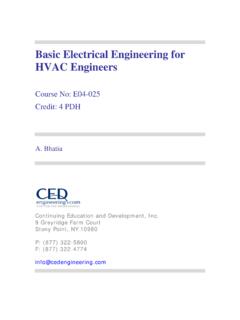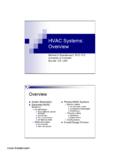Transcription of Guide to Home Heating and Cooling - Energy
1 Types of Heating & Cooling SystemsThere are many different kinds of Heating and Cooling systems you can use in your air conditioners . Since January 2006, all residential air conditioners sold in the United States must have a SEER of at least 13. Energy STAR qualified central air conditioners must have a SEER of at least 14. By upgrading from SEER 9 to SEER 14, you can reduce your Energy consumption by more than 35%. If you are paying $100 per month in direct Cooling costs, you could reduce your monthly utility bill by up to $35 by switching to the SEER 14 rated air conditioning system. Room air conditioners . When buying a new room air conditioner, look for units with EER of 10 or higher. The Energy STAR website, found in Further Reading, carries additional specifications.
2 Guide to Home Heating and CoolingWhether you are in the market for a new Heating and Cooling system or looking for ways to make your existing one more efficient, these guidelines can help you get the most out of your investment. Buying a New SystemIf your Heating or Cooling system is over 15 years old, you can save on electric bills and improve your home s Energy efficiency by investing in new equipment. The system you choose will depend on the size of your house, amount of insulation, Heating and Cooling usage, and local climate. Look for systems with the Energy STAR label, which meet performance requirements established by the Environmental Protection RatingsAir conditioner efficiency measures how well a system cools a given space and the amount of electricity needed to do so.
3 Two measures of air conditioner efficiency are the Seasonal Energy Efficiency Ratio (SEER) and the Energy Efficiency Ratio (EER). SEER equals the Cooling output of a system divided by its overall power consumption during the Cooling season ( , the warm part of the year). EER is similar except it measures the instantaneous efficiency rather than over an entire season. Window units use EER, while central air condition-ing systems use both SEER and EER. The higher the SEER and EER ratings, the more Energy -efficient the system. Clockwise from top left: iStockphoto # s 13056391, 2861497, 10783680, 4244472 Determining HVAC System SizeThe size of a Heating or Cooling system will determine not only its ability to heat or cool your home, but also the size of your Energy bills.
4 Oversized Cooling systems can be noisy, provide inadequate thermal comfort, and lead to mold and poor indoor air quality while costing too commonly accepted old estimate is that an HVAC unit should provide one ton (12,000 Btu) of Cooling for each 400 to 500 square feet of building area. However, this rule does not take into account local climate and how well a house is sealed and insulated. In a very efficient house, one ton can condition 800 to 1,000 square feet. Insist that your contractor use the Air Conditioning Contractors of America (ACCA) Manual J to calculate the proper size of Heating and Cooling Source heat pumps . Air source heat pumps combine Heating and Cooling capabilities. Look for Energy STAR qualified heat pumps with a SEER of 14 or greater.
5 Also consider how efficiently the heat pump is during colder times of the year. The Heating Seasonal Performance Factor (HSPF) is the ratio of the total heat output of a heat pump during the normal Heating season divided by the total Energy consumed during that period. Energy STAR qualified heat pumps have a HSPF of eight or Furnaces use fuel (natural gas and oil) to create heat . The Annual Fuel Utilization Efficiency (AFUE) measures the amount of heat actually delivered to your house compared to the amount of fuel supplied to the furnace. The higher the AFUE number, the more efficient the system. To earn the Energy STAR label, oil and gas furnaces must have an AFUE of 85% and 90%, respectively, or MaintenanceFollowing a regular maintenance schedule can reduce your Heating and Cooling costs by 5% to 10% and prolong the life of the in preventative checkups.
6 Hire a professional HVAC technician to inspect systems for proper function. air conditioners should be inspected in the spring and furnaces should be checked in the fall. Consult the owner s manual. Your owner s manual should provide details on system maintenance and or replace filters monthly during seasons of peak use. Cleaning and replacing filters will reduce Heating and Cooling bills while also extending the life of the equipment. Seal duct leaks. Sealing ducts with fiberglass mesh and mastic can control humidity and dust. Many HVAC service companies will do this at a reasonable price. Keep the area clean around outdoor air conditioners and heat pumps . Clear away weeds and debris so that air can circulate freely around the unit.
7 Check for disconnected or crushed duct work. Improperly connected or crushed duct work can restrict flow so that warmed or cooled air never reaches its intended destination. Best PracticesYou can save as much as 10% on Heating and Cooling costs by adjusting your thermostat when you are not at home and while sleeping. For winter time, set thermostats to 68 F when you are awake and set it back while you sleep. You can save 1% on Heating bills for each 1 F you set it back during an eight-hour period. However, keep in mind your comfort with temperatures set too low. For summer, when you are not at home, set your thermostat to 78 F. With a programmable thermostat, you can program it to return to a preferred temperature before you get these best practices to help lower your utility costs and increase your home s Energy efficiency: Close the damper when the fire-place is not in use.
8 Let in sunlight during the Heating season, and close the drapes against summer sun to reduce heat gain. Keep air vents clean and unobstructed. Air seal and insulate. Further ReadingENERGY STAR on Air Source heat pumps Energy STAR on Central air conditioners Energy STAR on Furnaces HVAC Sizing Practice IncentivesTax credits, incentives, and rebates may be available in your area. Please visit for more Information Center1-877-EERE-INFO (1-877-337-3463) with a renewable-source ink on paper containing at least 50% wastepaper, including 10% post consumer October 2010










